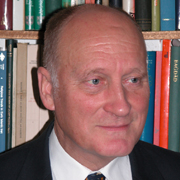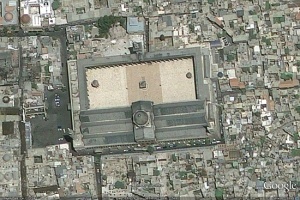The Great Hall at Kings’ College, London was packed again this year as over 250 people enjoyed the lecture by Professor Robert Hillenbrand. The subject matter of “Byzantine Architecture reconfigured in early Islamic Syria” did not at first seem so inspiring but the delivery was a remarkable tour de force by an academic truly in command of his subject matter. The only disappointment of the evening was the buffet afterwards which as bland as the Syrian desert which surrounded many of Professor Hillenbrand’s illustrations.
Introducing the subject Professor Hillenbrand placed us in time in the period 661 to 750 AD. This was a period of enormous change throughout the Mediterranean, Europe, North Africa and Asia as far as India and China. The inhabitants of those places lived through the virtual firestorm of the rise of Islam and its subsequent conquests which, in the one hundred years following the death of the Prophet Mohammed, saw an Islamic empire suddenly emerge, stretching from the borders of France, through to China. This empire of the Umayyads brought untold wealth to the hugely confident and seemingly invincible people who just a few decades earlier were to be found only in an obscure corner of the Arabian Peninsula. Only the Byzantine Empire held out; much reduced and battered, but it remained a bulwark against Islamic expansion in the northern Mediterranean until the Fall of Constantinople in 1453.
They used their wealth to build, but little of their architecture survives outside of ‘Greater Syria’ where forced labour was used to build a legacy of the empire.
Professor Hillenbrand‘s hypothesis was that Umayyad architecture went through three main phases: copying what they found around them, particularly Roman buildings; ‘tinkering’ with existing architectural styles; and finally transformation into a distinctive Umayyad style.
When it came to copying, there can be no better example than the Dome of the Rock and its adjacent Al Axa mosque. (pics). The style and positioning of both buildings bear a very close resemblance to the Church of the Holy Sepulchre and its nearby basilica. Even the diameters of the domes vary by only one centimetre! The decoration copied small details from Hagia Sophia on a huge scale. Professor Hillenbrand did not take questions, but I would have liked to know where the Umayyads found their architects, craftsmen and their mosaic artists. Were they by any chance Byzantines who could not find employment in an impoverished imperial capital?
This copying even extended to whole cities. They chose the Roman rectilinear city shape based upon a strict grid pattern. Islamic bathhouses in Syria bear a very close resemblance to the Roman bathhouses at Leptis Magna. They were either consciously or unselfconsciously leapfrogging back to ancient Rome. They chose not to copy the Byzantine style for they were the remaining enemy; the one to beat.
The presentation of the move to the ‘tinkering’ phase was perhaps less convincing. The precise external layouts of Roman frontier forts were copied even down to the standard sizing of wall lengths: 35m, 70m, and 140m. Professor Hillenbrand argued that many instances of ‘tinkering’ with previous Roman designs can be identified. For instance, rather than build the Spartan, utilitarian forts of the Romans with very few comforts or accommodation, the Umayyads chose to cram the forts with buildings, some in effect luxurious residences for local administrators or higher officials who used the forts to oppress and dominate their new conquests. This improvement sounds like a pretty practical step rather just some subtle form of evolution. They often added decorative features such as making the gateways elaborate which the Romans rarely did.
The Great Mosque in Damascus was classified in the tinkering category, but for me this building belongs into the transformational or final stage. This building took the Christian basilica layout of a transept and nave and switched the nave around to run east west allowing a huge frontage of worshippers to face towards Mecca to pray. I learned that this mosque has the largest surviving wall mosaic in the world. This is fantasy architecture based upon the Roman style.
When discussing the transformation stage, Professor Hillenbrand suggested that the Umayyads had taken classical Roman models and transformed these building designs into something else. The Kaliph’s palace at Mufjar (??) has thirty nine mosaic carpets in its bathhouse alone. This is the largest remaining floor mosaic in the world. The playboy Kaliph builder of this palace offended Islam so much that he had a price placed upon his head and was killed eighteen months after the fatwa was ordered.
Maybe the thread was lost but for me the lecture ended at about this point. Professor Hillenbrand concluded by saying that these examples of early Islamic art were free flowing and propagandist, and that the Umayyad dynasty brought classical art into the mainstream of Islamic art.
The lecture was well worth attending. It is often difficult to make notes whilst keeping up with a subject that may be unfamiliar, but I hope that this account offers you a flavour of the thrust of the lecture. Next year the Runcimam lecture will be about Byzantine medicine which made my medical student daughter’s ears prick up. Something to look forward to.
Related article: 18th Annual Runciman Lecture
Related article: Syria’s Mysterious Dead Cities







Pingback: Poor performance or anti-Greek conspiracy? The campaign to save the Department of Byzantine and Modern Greek Studies at King’s College London is controversial « Byzantine Blog
Pingback: Centre for Hellenic Studies King’s College London: a new future? « Byzantine Blog
Pingback: Byzantine herbs and drugs – the magical and dangerous mandrake « Byzantine Blog
Pingback: Byzantine Herbs and Drugs – The Poison Aconite or Wolfsbane « Byzantine Blog
Pingback: Hagia Sofia: Dome Secrets « Byzantine Blog
Very helped and informative contents, I read great articles on http://crusades-medieval.blogspot.com
Pingback: Twentieth Annual Runciman Lecture “Surgery in Byzantium” – 3 February 2011 « Byzantine Blog
Pingback: Caliph Harun Al-Rashid Era – A Golden Age of Islamic Civilization « Byzantine Blog
The Arabs NEVER have to copy from any civilization. They have their own civilization.
In Genesis
2 And I will make my covenant between me and you, and will multiply you exceedingly.”
3 Then Abram fell on his face; and God said to him,
4 “Behold, my covenant is with you, and you shall be the father of a multitude of nations.
5 No longer shall your name be Abram, but your name shall be Abraham; for I have made you the father of a multitude of nations.
6 I will make you exceedingly fruitful; and I will make nations of you, and kings shall come forth from you.
20 As for Ismael, I have heard you; behold, I will bless him and make him fruitful and multiply him exceedingly; he shall be the father of twelve princes, and I will make him a great nation.
The ancestors of the Ismaelites were of great kingdoms / civilization.
Pingback: Early Christian architecture | modusvivendi2013
Pingback: Early Christian architecture | europeanSaurus